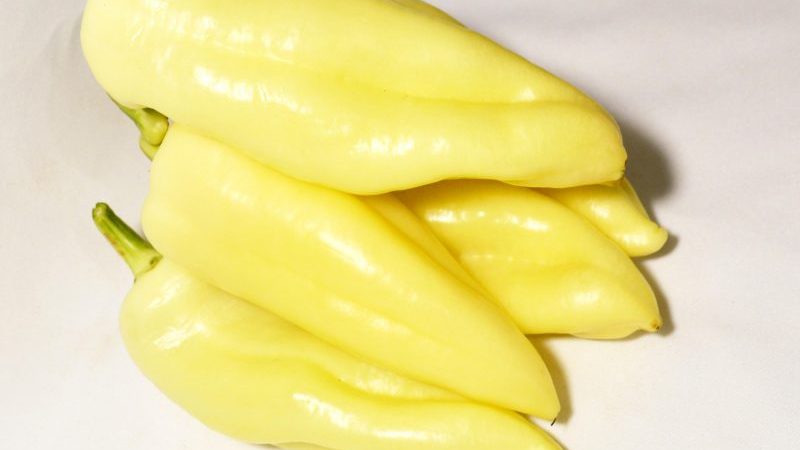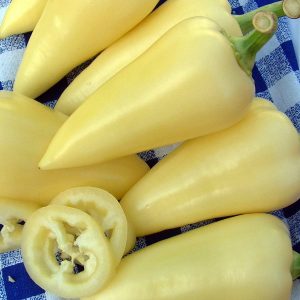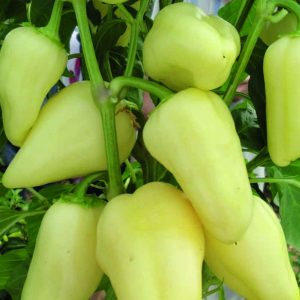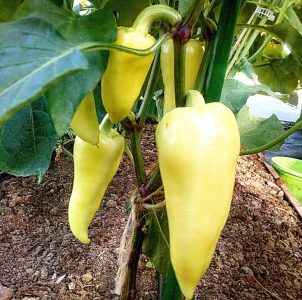Why the Belozerka pepper variety is good and why it is worth trying to grow it on your site
Sweet pepper Belozerka has been popular among gardeners for about 30 years. This is an unpretentious variety that is resistant to diseases and pests.
In the article, we will consider the secrets of growing pepper, its advantages and disadvantages, and also share the reviews of farmers about this variety.
The content of the article
Description of the variety
In the 90s of the last century, scientists created a variety known today as Belozerka sweet pepper. Breeders, by crossing different crops, tried to get a kind of pepper that can grow in any climate - both in greenhouses and in the open field, with a good yield indicator.
Their work was crowned with success: the Belozerka variety meets all the declared characteristics.

It is a determinant pepper with limited bush growth. It also has the following features:
- plant height does not exceed 70 cm;
- from the strong central stem are the same strong branches with dark green boat-shaped leaves;
- bushes do not require a garter;
- the root system of plants is well developed;
- white flowers in the form of stars;
- self-pollinated variety.
On a note. To increase yields, other varieties of pepper are planted next to Belozerka, pollinated by bees.
Fruit and yield
Belozerka produces cone-shaped fruits with firm and juicy pulp. The surface of the fruit is glossy, smooth, the apex is slightly pointed. The fruits have several facets. The wall thickness is 4-7 mm.
The peppers themselves are average in weight and size - the weight of one fruit is 80-90 g.
The yield of the variety is high - during the season you can get up to 9 kg of vegetables from 1 sq. m.
The color of ripe fruits is bright red. They are stored for a long time, do not lose their useful and taste qualities.
It is a versatile vegetable crop that is used for both canning, and for the daily preparation of various dishes:
- lecho;
- salads;
- soups;
- stuffing;
- adjika.
On a note. Bell pepper is rich in vitamin C, its regular use helps to increase immunity, cleanses blood vessels, increases appetite, and normalizes blood counts.
Germinating seeds
The vegetable is cultivated by the seedling method. The seeds are germinated in a warm place with high humidity levels. As soon as the first shoots appear, the seeds are planted in the soil, which should be nutritious and loose. It is best to use a store-bought potting potting mix for vegetables or flowers.
Each plant is placed in a separate container - then it is easier to transplant them into open ground. At this stage, it is important to provide the seedlings with good lighting and watering (not to allow the soil to dry out).
Top dressing
The culture is fed with a small amount of superphosphate and potassium fertilizers immediately after the appearance of cotyledon leaves... The second feeding is done when more than ten true leaves are formed and the pepper reaches 10 cm in height.
For this, chemical compositions are used at the rate of 15 g of superphosphate and 5 g of potassium per 5 liters of liquid at room temperature. The indicated proportions should be strictly observed, otherwise the crop will be oversaturated with nitrates.
Important! Seedlings do not dive - Belozerka does not tolerate this procedure.
Plants planted in open ground are fed several times during the entire life cycle.
During the period of ovary formation and flowering, the first feeding is performed, the second - when the fruits ripen.
Open ground
Peppers are planted in open ground no earlier than mid-May, when there are no cold nights and sudden changes in air temperature during the day.
They do it as follows:
- at a distance of 30-40 cm from each other, dig holes 20 cm deep;
- the bottom of each hole is covered with humus - for good rooting of plants in a new place;
- the plant is taken out of the container along with a lump of earth, placed in a prepared hole and covered with earth until the first leaves;
- watered with warm water - under one bush 2-3 liters.
Before planting seedlings in open ground, the bushes must be prepared - hardened. First, they are taken out on the street for a day, later they are left for the whole night. Hardening increases the endurance of the crop after transplanting.
Pepper care
The Belozerka variety requires the usual care for most unpretentious crops - watering, feeding, weeding. The main thing is to exclude decay, drying out, illness and protect it from pests.
Watering
Do not overdry the soil until cracks form. In hot weather, the frequency and amount of watering is increased - in dry weather, 3-4 liters of warm water are poured under one bush (2-3 times every 7 days).
Fertilizers
They are fed with both chemical and organic substances. Potash, nitrogen or phosphate fertilizers are diluted with liquid in strict accordance with the instructions. For organic feeding of pepper, humus, compost or dry chicken droppings are used.
Important! You cannot fertilize a crop with fresh manure - the plants may die.
Soil aeration

The soil should be loosened periodically to improve its breathability and to ensure good water absorption.
Do this carefully, otherwise there is a risk of disrupting the root system of plants (the depth of penetration is not more than 7 cm).
Weeding
The grass is harvested by hand or with a hoe as it grows around the Belozerka bush. Weeds prevent plants from getting all the necessary trace elements from the soil and from developing.
If there is a lot of extra grass in the garden, the pepper begins to hurt, it becomes more vulnerable to attack by insect pests.
Mulching
The main task of the procedure is to retain moisture in hot weather. The hole is mulched using hay, straw or cut grass. This provides the necessary moisture at the root part and keeps it cool.
Diseases and pests
Treatment with special solutions against pests or diseases is performed only if necessary. Plants are carefully inspected for damage to fruit or leaves. It is important to determine the real cause of the defeat in order to find an effective method of struggle.
Pepper variety Belozerka is resistant to apical, dry and wet rot, an alternative, verticillosis and viral diseases. Spraying with chemicals for diseases or pests is rarely required.
Advantages and disadvantages
Sweet pepper Belozerka has no significant drawbacks. The small disadvantages include the lack of thick pulp and large mass, compared to other varieties.
But the advantages of "Belozerka" are obvious:
- high productivity;
- even and beautiful fruits;
- excellent taste even at the stage of technical ripeness, when vegetables are still white with a green tint;
- long fruiting;
- resistance to various weather conditions;
- good transportability and keeping quality;
- resistance to viruses and fungi.
Reviews
Let's take a look at some online pepper reviews so you can get a more objective picture of yourself and make your final purchase decision.
Elena, Yekaterinburg: «My parents plant Belozerka pepper every year and are very pleased with the result - the fruits are bright and early. Even after stewing the stuffed peppers, the color remains pleasant, and the dish is delicious! "
Ivan, Moscow: “A good pepper, although it is not very large. The main thing is to fertilize it with humus in time, water and mulch, then the yield will not fail. I reaped an excellent harvest in the cold summer. "
Lyudmila, Perm: “I like Belozerka for its beautiful and even fruits. Another plus - you can pick unripe peppers and use the whole season (until the end of August).There is no harm to the plant from this, only benefit - after harvesting the first fruits, new ones appear faster ”.
Conclusion
Sweet pepper Belozerka does not require special care and special conditions for cultivation.
The variety tolerates temperature changes well, gives an excellent yield and does not need frequent use of chemical fertilizers. Be sure to try growing it on your site!